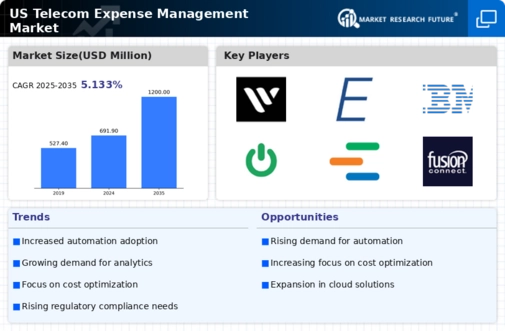Rising Operational Costs
The telecom expense-management market is experiencing a surge in demand due to rising operational costs faced by organizations. As companies strive to optimize their budgets, the need for effective expense management solutions becomes paramount. In 2025, it is estimated that telecom expenses account for approximately 3-5% of total operational costs for many businesses. This trend indicates a growing awareness among enterprises regarding the importance of managing telecom expenses efficiently. By leveraging telecom expense-management solutions, organizations can identify cost-saving opportunities, streamline processes, and enhance overall financial performance. The increasing complexity of telecom billing and the variety of services offered further necessitate the adoption of specialized management tools, making this driver a critical factor in the growth of the telecom expense-management market.
Shift Towards Remote Work
The telecom expense-management market is witnessing a notable shift towards remote work, which has transformed how organizations manage their telecom expenses. As remote work becomes a permanent fixture for many companies, the demand for effective telecom expense management solutions has surged. In 2025, it is projected that remote work-related telecom expenses will account for over 30% of total telecom costs for businesses. This shift necessitates a reevaluation of existing expense management practices, as organizations must now account for increased mobile and internet usage among remote employees. Consequently, telecom expense-management solutions that provide visibility and control over these expenses are becoming increasingly vital. This driver underscores the importance of adapting to changing work environments and the role of telecom expense-management in facilitating this transition.
Regulatory Compliance Requirements
The telecom expense-management market is significantly influenced by the evolving landscape of regulatory compliance requirements. Organizations are increasingly required to adhere to various regulations concerning data privacy, financial reporting, and telecommunications services. In the US, compliance with regulations such as the Federal Communications Commission (FCC) guidelines and the Sarbanes-Oxley Act has become essential for businesses. Failure to comply can result in substantial fines and reputational damage. Consequently, companies are turning to telecom expense-management solutions to ensure they meet these regulatory standards while effectively managing their telecom expenses. This driver highlights the necessity for organizations to integrate compliance features into their expense management strategies, thereby fostering growth in the telecom expense-management market.
Increased Focus on Cost Optimization
The telecom expense-management market is experiencing heightened interest due to an increased focus on cost optimization among organizations. As businesses strive to enhance profitability and operational efficiency, managing telecom expenses has emerged as a critical area of focus. In 2025, it is estimated that organizations that implement effective telecom expense-management solutions can achieve cost savings of up to 25%. This potential for significant savings is driving companies to invest in specialized management tools that provide visibility into telecom spending, identify inefficiencies, and streamline processes. The emphasis on cost optimization reflects a broader trend within organizations to leverage technology for financial management, thereby positioning the telecom expense-management market as a key player in the quest for operational excellence.
Technological Advancements in Telecom
The telecom expense-management market is being propelled by rapid technological advancements in the telecommunications sector. Innovations such as 5G technology, IoT devices, and advanced analytics are reshaping the telecom landscape, leading to more complex billing structures and service offerings. As organizations adopt these new technologies, they face challenges in managing their telecom expenses effectively. In 2025, it is anticipated that the integration of IoT devices will increase telecom expenses by approximately 20% for many businesses. This complexity necessitates the use of sophisticated telecom expense-management solutions that can provide insights into usage patterns, optimize costs, and enhance decision-making. Thus, the ongoing technological evolution serves as a significant driver for the growth of the telecom expense-management market.

















Leave a Comment